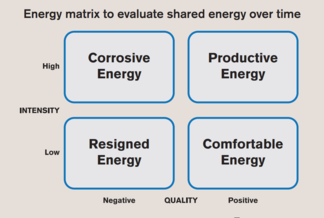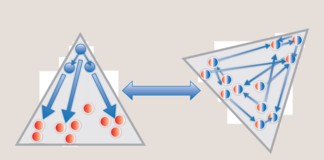COVID-19 and the Future of Leadership on Steroids
It is difficult to imagine that Covid-19 will not shape the business landscape for the foreseeable future. Therefore, and I have written this before and will repeat it here: In business and in my area of leadership and its development we owe it to those who have died and suffered, and those who still will be affected by Covid-19 in so many different ways, to take lessons from the current situation and make a positive change in all our spheres of life. Experiences of businesses, managers, and employees actually vary a lot.
Some organisations are still in crisis and face the unknown. They remain dormant – consider parts of the travel, hospitality, or entertainment industry. Others see more demand for their services and products than ever before – think online retailing, online meeting facilities, health care. And there are business split quasi in the middle, like John Lewis Partnership in the UK: Food retailing at Waitrose is buzzing while the John Lewis department stores were closed for much longer and the re-start is more challenging in a business environment that was already difficult – and all this under one roof.
Your brief: where is your organisation or your team or department in this mix? What are the lessons for leadership in your organisation so far and going forward?
However, Covid-19 also acted as a catalyst and unleashed the transformation of work, leadership and leadership development that was waiting in the wings to happen. Why? Because Covid-19 put the drive towards the future of work and leadership in organisations on steroids. In our study ‘Work 2028 – Trends, Dilemmas & Choices’ by the Henley Centre for Leadership in collaboration with Deutsche Telekom and Detecon Consulting, we researched how work and leadership will look in 2028. We identified 16 trends and subsequent implications. Covid-19 with its pace of disruption, surprise and uncertainty, but also the leadership vacuum and leadership richness we could observe, helped massively to transform leadership thinking and practices at speed and moved obstacles and rituals to the side.
Organisations, managers, employees are now nudged, pushed, pulled has to a direction we thought was further away. Instead we see the future of business energy, gig leadership, and democratising leadership development today! Here three observations and practical things that organisations can treasure, maintain, and do.

Bruch and Vogel, 2011
1. An organisation's shared energy is an indicator for pulling together at speed for success
For years we have been supporting organisations with a concept that we call the Energy of Organisation. In our book ‘Fully Charged’, we describe organisational energy as the extent to which a company, department, team has collectively mobilised its emotional, cognitive, and behavioural potential in pursuit of its goals. Sounds familiar? Recall how it felt, when in the early days of Covid-19 you and your colleagues were pulling together no matter what, with emotional involvement, and innovative thinking all around. We call this productive energy, and it helps the business to change and perform.
I regularly ask managers in my sessions at Henley Business School a simple question: What is the state of the teams or departments? Over and over, I hear that in such demanding times organisations manage to thrive thanks to the shared purposes or goals. You can see how the shared productive energy, the emotions, thinking and doing you collectively throw behind the absolute key activities is a key indicator to detect if your organisation or team is fully engaged for the key tasks – currently often the crisis or opportunities from Covid-19.
One energy pattern is particularly visible. We call this shock type energy trajectory. At a very fast pace, businesses are mobilising their people. From a positive or negative shock to the organisation like Covid-19, people report a steep and rapid increase of energy, until they are engaged at very high levels. However, now that the organisation is at peak involvement, in the highest gear and fully aligned for the shared goals, what then? This is where many organisations find themselves, or already beyond.
Your brief: Will your energy drop and crash as fast as it grew? Or are you working on sustaining productive energy with recovery periods and recharging in mind?
Many businesses are going for the latter. However, we now hear loud and clear different stories. Covid-19 as a galvanising threat or opportunity becomes less important and loses attention. Organisations drift back to their previous ways of doing things. Age-old in-fights across departments and toxic behaviours come back. Complacency and overconfidence resurface. Sounds familiar? Productive energy drops as a consequence. Instead, comfortable energy, resigned inertia, or corrosive energy are having a comeback in your teams and departments and jeopardise your busines success or survival – again!
Your brief: First, help managers learn to identify how the shared energy in their units goes up and down over time. Second, support leadership behaviour for a workforce that maintains to be enthusiastic, highly alert and puts full effort behind the core activities of the business – in the long-run and at healthy levels.

2. Gig Leadership – collective and rotating leadership by the many
Many times I heard the following recently: “The force and level of surprise with which Covid-19 hit us meant that we needed collective intelligence, decision making, and proactiveness at all levels, everywhere in the business, fast and strong. Some boundaries were set by central function and the exec group, however, locally we had to have high levels of liberties. We had to run the departments collectively, with various people, and seemingly free floating between the different levels of involvement in leadership and implementing.”
In our study 2028, mentioned earlier, we coined the term Gig Leadership as one potential trend. Gig Leadership in organisations means leadership rotates and involves the many, spans across functions and positions amongst managers, employees and gig workers – and in doing so responds to demands of tasks and business challenges. The last months saw a mass movement towards such rotating, inclusive, peer–to peer, collective leadership behaviour. People’s complementary qualities and capabilities were the drivers of who takes the helm of leadership in activities. We could see how Gig Leadership status has become a constant feature of workplaces. Gig Leadership by multiple people helps to spark the shared energy in organisations.
Still, substantial senior leadership is not obsolete! On the contrary, executives become the guardians that enable, protect, develop the conditions in which Gig Leadership thrives for business performance. Gig Leadership means in your organisation that the future of leadership meets energizing organisations at speed.
Your brief: First, are you a manager who developed the ability to step in and out of leadership and accept others temporarily taking the lead, even though accountability remains firmly with you? Second, did you notice and strengthen Gig Leadership as a capability in your organisation? Third, did you acknowledge the previously hidden leadership talent that has now surfaced? Do not forget to redefine your criteria for leadership success and promotion. Finally, if Gig and Rotating Leadership have missed the boat in your business, unleash a shake-up of leadership status and styles.
3. Democratising leadership development for all employees
I really miss working with individual managers, intact management teams, and groups in class. What a privilege to see in person how people are growing over months and years. I am longing to see some of our face-to-face world coming back.
Nevertheless, we also wrote in our future of leadership study the following about developing leadership capability: “We have to get uncomfortable – unlearning leadership development.” Decision makers in organisations and leadership developers like myself need to shed well-nurtured blinkers of leadership learning. This can be painful, but also exciting.
Covid-19 as a catalyst for change, helped many learning activities to finally start reaching large audiences in organisations. We saw leadership development as strategy learning and strategy sense making online, across management layers, time zones and gate keepers in places like mining business. Leadership training happened in small chunks for all, to help the business lead in virtual settings. Teams went in self-development mode to strengthen how to remotely manage key leadership tasks of coordination and alignment. These are steps towards disruptive, multilevel leadership learning for all employees.
Programme-based leadership learning has tremendous value and works as a catalyst for change. But it is also gatekeepercontrolled learning. Organisations can embrace ways to harvest leadership learning on the job and in doing so will democratise leadership development.
Your brief: Do you acknowledge that all employees contribute to leadership and do all benefit from development – also an anchor for loyalty? What ritual in leadership development have you un-learned? How far does your organisation understand and assess the impact of developing leadership capacity for individuals, peers at works and beyond, and for society, for instance in view of the United Nations Sustainable Development Goals?
Try NOT to smash the genie back into the bottle. Good luck
We hear loudly and clearly that organisations are working hard to secure the progress they have made in recent months in leadership skills, identity and development. At the same time, other organisations are also doing their best to smash the genie back into the bottle.
Some managers move back to and try to push through a simplified view of how people in organisations thrive and how successful leadership is happening. They confuse control with guidance, muddle simplicity with clarity, focus on stories of individual success instead of the underlying collective effort, or point to individual failure where organisations lack systematic enabling.
Not only might this undo all the progress you have made, it can create distrust and undermine the relationships that have been flourishing recently between the organisation and your colleagues.
You have one task: Don’t be tempted.


